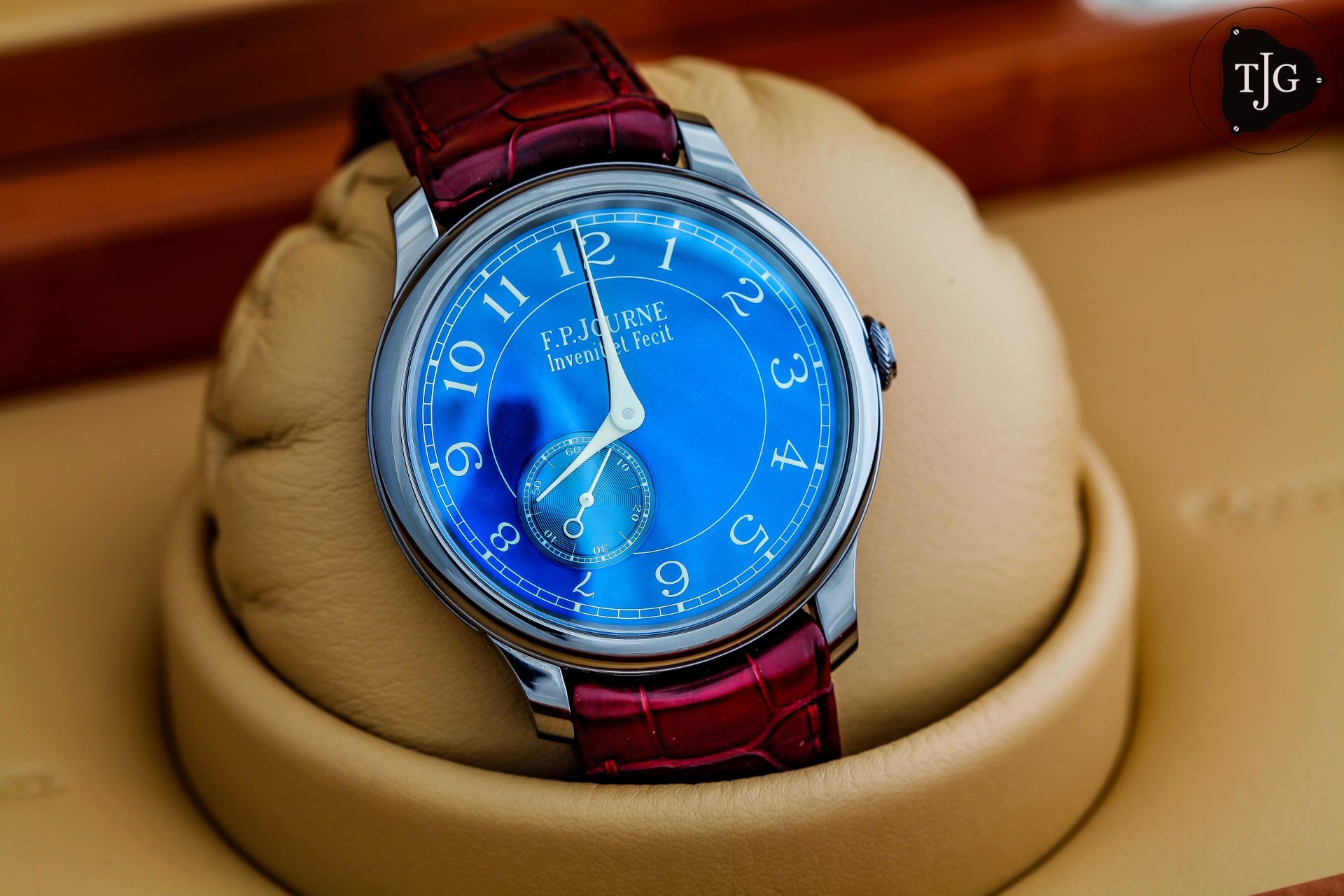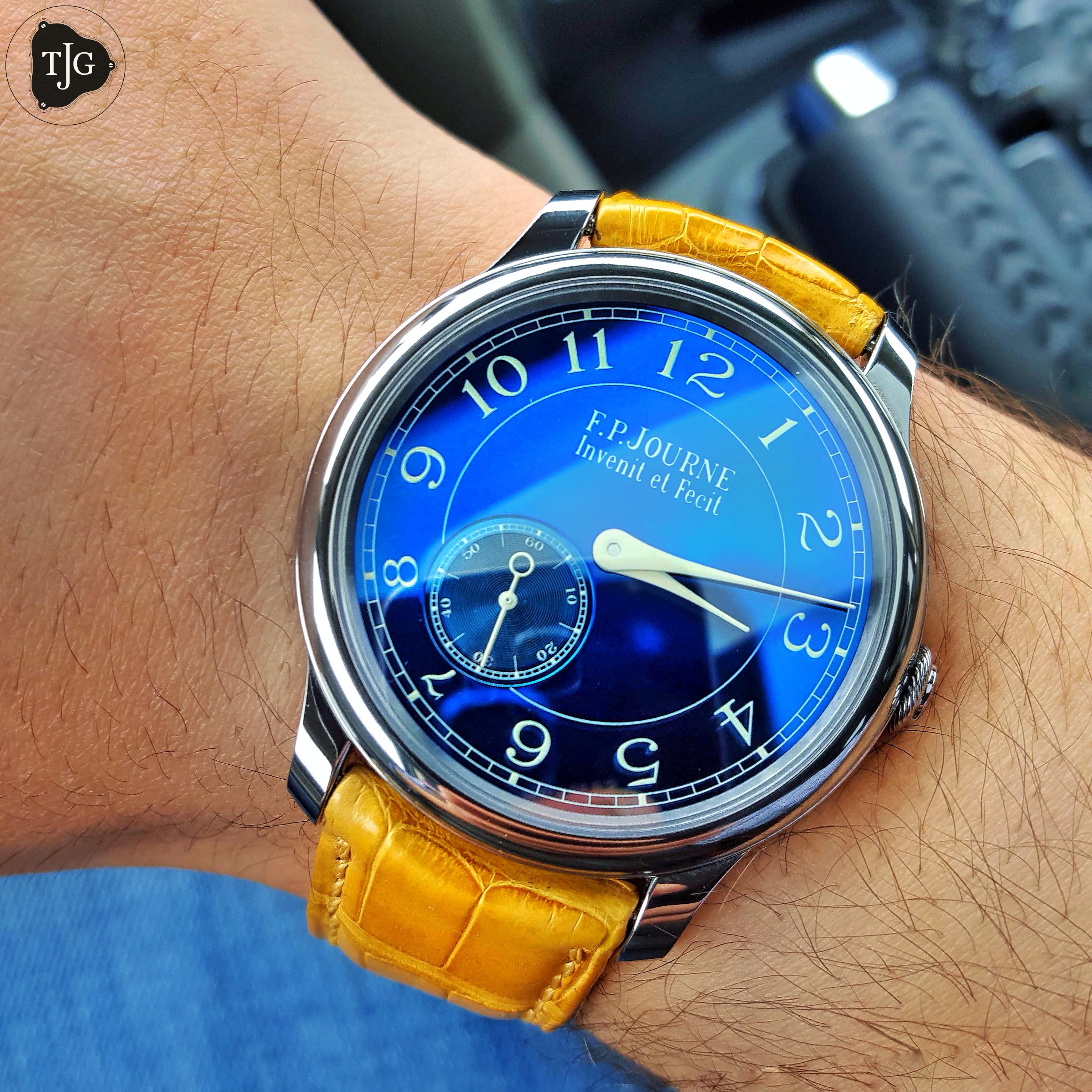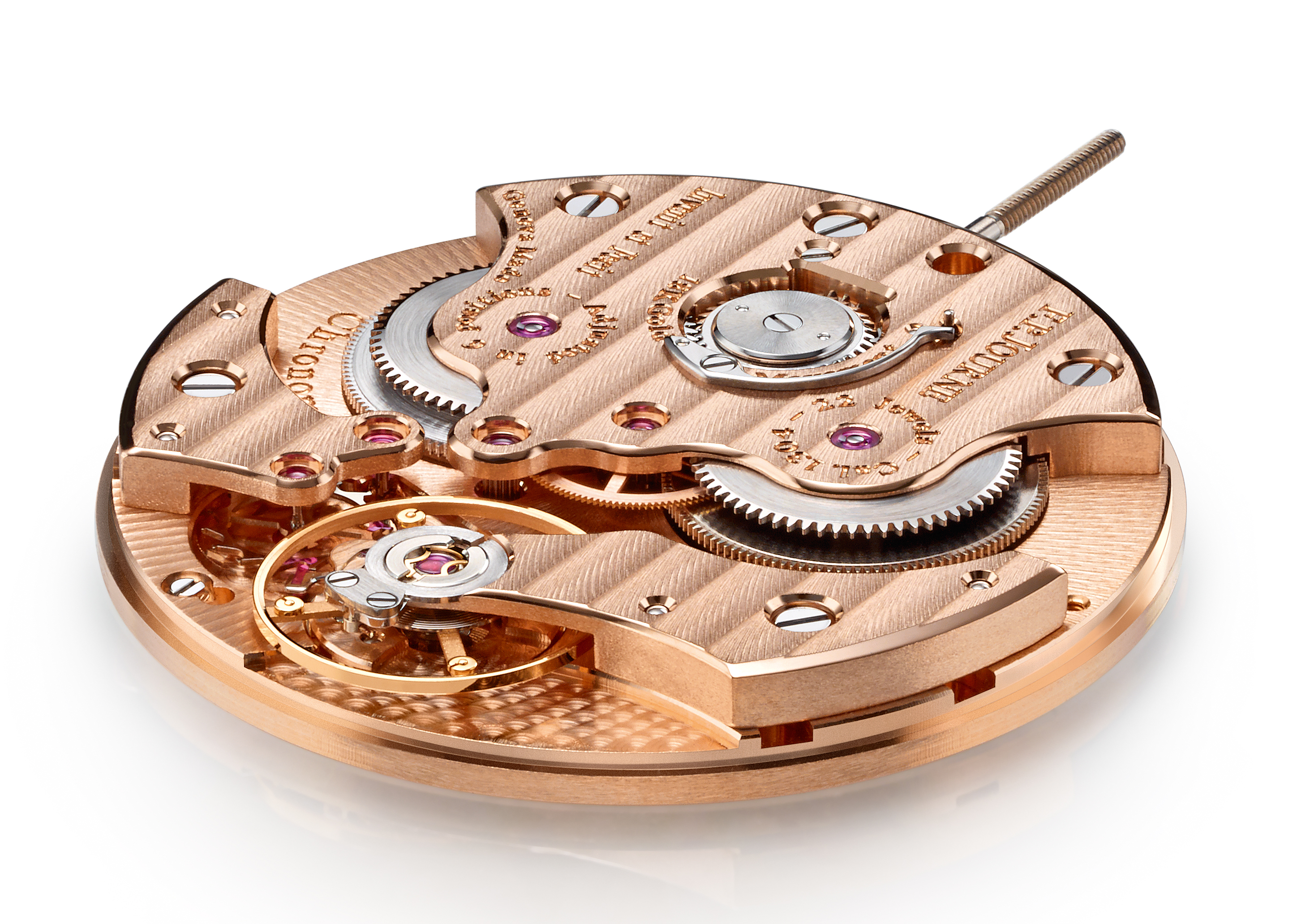F.P. Journe-Edzilla? Du må da være på god vei til å bli F.P. Journes ekvivalent til Tesla-Bjørn. Har de også kanskje noe referral program? Synes du bør kreve det med tanke på publisiteten du skaper.
F.P.Journe-tråden
- Trådstarter Havvo
- Opprettet
Du bruker en utdatert nettleser. Det kan ikke vise dette eller andre nettsteder på riktig måte.
Du bør oppgradere eller bruke en alternativ nettleser.
Du bør oppgradere eller bruke en alternativ nettleser.
F.P. Journe-Edzilla? Du må da være på god vei til å bli F.P. Journes ekvivalent til Tesla-Bjørn. Har de også kanskje noe referral program? Synes du bør kreve det med tanke på publisiteten du skaper.

Morro å se denne i etterkant av reisebrevet deres @andres og @Edzilla : https://www.hodinkee.com/videos/fp-journe-grande-sonnerie-video
Disse er så rå. Skulle ønske de fortsatt hadde en serie som bar preg av håndverket på samme måte som disse, men de dagene er vel forbi.
Disse er så rå. Skulle ønske de fortsatt hadde en serie som bar preg av håndverket på samme måte som disse, men de dagene er vel forbi.
Tja. Graver du dypt nok i lomma, så lager F.P. Bespoke klokke for deg.
Tja. Graver du dypt nok i lomma, så lager F.P. Bespoke klokke for deg.
Så rått når de dukker opp innimellom med okyderte skiver osv. Elsker graveringsfonten også.
Så rått når de dukker opp innimellom med okyderte skiver osv. Elsker graveringsfonten også.
Er så enig!
Lurer på hvor mange eksemplarer av de andre klokkene det lages i året (minus 5980a, 15400 blå og Snoopy)?
Vis vedlegg 144508
Patek produserer visstnok 55,000 mekaniske klokker i året... hvis man kan stole på presentasjonen som ble gitt av Patek til noen heldig utvalgte, inkludert mannen bak Instagram profilen watchrookie. Så blir nok i allefall produsert vesentlig flere Nautiluser enn Bleu

Må være mange ganger flere 5711 vs. Bleu i året.
For øvrig bemerkelsesverdig at det som må være Journe minst sjeldne klokke, vel omtrent er eneste modell som selger brukt over retail. Er mildt sagt merkelig endring at man kan få en Souverain platina brukt til 30% mindre enn en brukt Bleu. Og Souverain får man også i enda nettere 38mm hvis man ønsker det.
For øvrig bemerkelsesverdig at det som må være Journe minst sjeldne klokke, vel omtrent er eneste modell som selger brukt over retail. Er mildt sagt merkelig endring at man kan få en Souverain platina brukt til 30% mindre enn en brukt Bleu. Og Souverain får man også i enda nettere 38mm hvis man ønsker det.
Må være mange ganger flere 5711 vs. Bleu i året.
For øvrig bemerkelsesverdig at det som må være Journe minst sjeldne klokke, vel omtrent er eneste modell som selger brukt over retail. Er mildt sagt merkelig endring at man kan få en Souverain platina brukt til 30% mindre enn en brukt Bleu. Og Souverain får man også i enda nettere 38mm hvis man ønsker det.
Men dagens Chronometre Souverain blir bare produsert i 40mm kasse. Skal man ha 38mm så må man kjøpe brukt. Husker jeg rett så slutten F.P. Journe å produsere 38mm kassene i oktober 2015.


Helt korrekt. Det var bruktprisforskjellen og bruktkjøpsmulighetene jeg refererte til.
Da er vi enige
Why the CB Production is Becoming More Limited for 2019
in FP JOURNE NEWS on MAY 7, 2019 SHARE

The Chronometre Bleu (CB) which was first presented in 2009 and widely known to have been made in response to the economic recession of 2008, is more popular today that it has ever been before. At start, like many of Journe’s models, it wasn’t extremely well received and yet today, the waiting lists at the boutiques are so long that corporate has requested to stop accepting any more names onto the list. What started with a 6-month wait is now at 7 years or more, a very ridiculous wait if I must chip in.
All that said, the CB production has continuously drifted along the lines of 190 pieces per year, or at least that was what the company kept aiming for each year. Compared to the rest of Journe’s annual production, that might seem like a large number considering the brand’s annual aim of 900 pieces (but almost never achieved lately); though almost nothing compared to what some other brands produce. As an example to think over, Journe as a fully established brand doesn’t come close to 1,000 pieces anually whereas some of its larger competitors like Patek Philippe pump out nearly 80x more watches per year.
Still, with all the long waiting lists you would imagine the brand’s need to focus more production towards the CB, yet on the contrary the manufacture has stated that the production will actually be reduced to 100 pieces for 2019. This might seem like the illogical decision but let’s break down the factors I’ve gathered regarding this.

First, the manufacture has a small number of watchmakers estimating 20-25, and unlike other brands, the manufacture does not run on a “stage-assembly” line but rather, each watchmaker makes his/her watch entirely from A to Z. Further, each watchmaker is generally trained for each specific caliber they work on, and all the calibers are thus split among the team (though not necessarily equally). The split includes the whole collection from the CB/CS cal. 1304 to the now discontinued cal. 1505 of the Sonnerie Souveraine.
Understanding that not all the models have the same demand, nor the same complexity to complete, we could speculate that if all the watchmakers focused solely on the CB, they might push out at least 1,500 pieces of that one model. Sounds like a great idea but at the cost of…
Second, the incredibly small profit margin of the CB. With the most expensive dial they make and the most complicated and time-consuming case they make, the CB has an extremely small success rate and an incredibly expensive production cost. It is said that the goal of the watch at inception was to sell it at roughly $15,000 in 2009. After many trials, Journe couldn’t possibly make that happen and so he went on to present the watch around $20,000 and while today’s price is just short of $25,000, Journe has continuously struggled to keep the price as low as possible. In fact, the price rise over recent years is not one of increasing profit but more due to the cost of the production rising from the case and dial makers themselves, which Journe kept trying to counter.

Calibre 1304 (CS & CB)
According to Journe, the most stable movement he makes.
With these two factors, we can deduce that the manufacture’s decision to lower the annual production is simply logic and not greed or being downright evil. While they are in the middle of redesigning their LineSport and introducing the new Tourbillon Vertical, they also receive demand for those pieces and thus need to split the watchmaking accordingly. The CB might have a tremendous demand but it makes no sense to prioritize it in favor of every other model in the book. Thus, lowering production to 100 from 190 is just a better means of reaching equilibrium among the production.
in FP JOURNE NEWS on MAY 7, 2019 SHARE

The Chronometre Bleu (CB) which was first presented in 2009 and widely known to have been made in response to the economic recession of 2008, is more popular today that it has ever been before. At start, like many of Journe’s models, it wasn’t extremely well received and yet today, the waiting lists at the boutiques are so long that corporate has requested to stop accepting any more names onto the list. What started with a 6-month wait is now at 7 years or more, a very ridiculous wait if I must chip in.
All that said, the CB production has continuously drifted along the lines of 190 pieces per year, or at least that was what the company kept aiming for each year. Compared to the rest of Journe’s annual production, that might seem like a large number considering the brand’s annual aim of 900 pieces (but almost never achieved lately); though almost nothing compared to what some other brands produce. As an example to think over, Journe as a fully established brand doesn’t come close to 1,000 pieces anually whereas some of its larger competitors like Patek Philippe pump out nearly 80x more watches per year.
Still, with all the long waiting lists you would imagine the brand’s need to focus more production towards the CB, yet on the contrary the manufacture has stated that the production will actually be reduced to 100 pieces for 2019. This might seem like the illogical decision but let’s break down the factors I’ve gathered regarding this.

First, the manufacture has a small number of watchmakers estimating 20-25, and unlike other brands, the manufacture does not run on a “stage-assembly” line but rather, each watchmaker makes his/her watch entirely from A to Z. Further, each watchmaker is generally trained for each specific caliber they work on, and all the calibers are thus split among the team (though not necessarily equally). The split includes the whole collection from the CB/CS cal. 1304 to the now discontinued cal. 1505 of the Sonnerie Souveraine.
Understanding that not all the models have the same demand, nor the same complexity to complete, we could speculate that if all the watchmakers focused solely on the CB, they might push out at least 1,500 pieces of that one model. Sounds like a great idea but at the cost of…
Second, the incredibly small profit margin of the CB. With the most expensive dial they make and the most complicated and time-consuming case they make, the CB has an extremely small success rate and an incredibly expensive production cost. It is said that the goal of the watch at inception was to sell it at roughly $15,000 in 2009. After many trials, Journe couldn’t possibly make that happen and so he went on to present the watch around $20,000 and while today’s price is just short of $25,000, Journe has continuously struggled to keep the price as low as possible. In fact, the price rise over recent years is not one of increasing profit but more due to the cost of the production rising from the case and dial makers themselves, which Journe kept trying to counter.

Calibre 1304 (CS & CB)
According to Journe, the most stable movement he makes.
With these two factors, we can deduce that the manufacture’s decision to lower the annual production is simply logic and not greed or being downright evil. While they are in the middle of redesigning their LineSport and introducing the new Tourbillon Vertical, they also receive demand for those pieces and thus need to split the watchmaking accordingly. The CB might have a tremendous demand but it makes no sense to prioritize it in favor of every other model in the book. Thus, lowering production to 100 from 190 is just a better means of reaching equilibrium among the production.
Del:






